
6 Train Routes in the West for Any Traveler
All aboard, train lovers and skeptics—there’s a route for you.
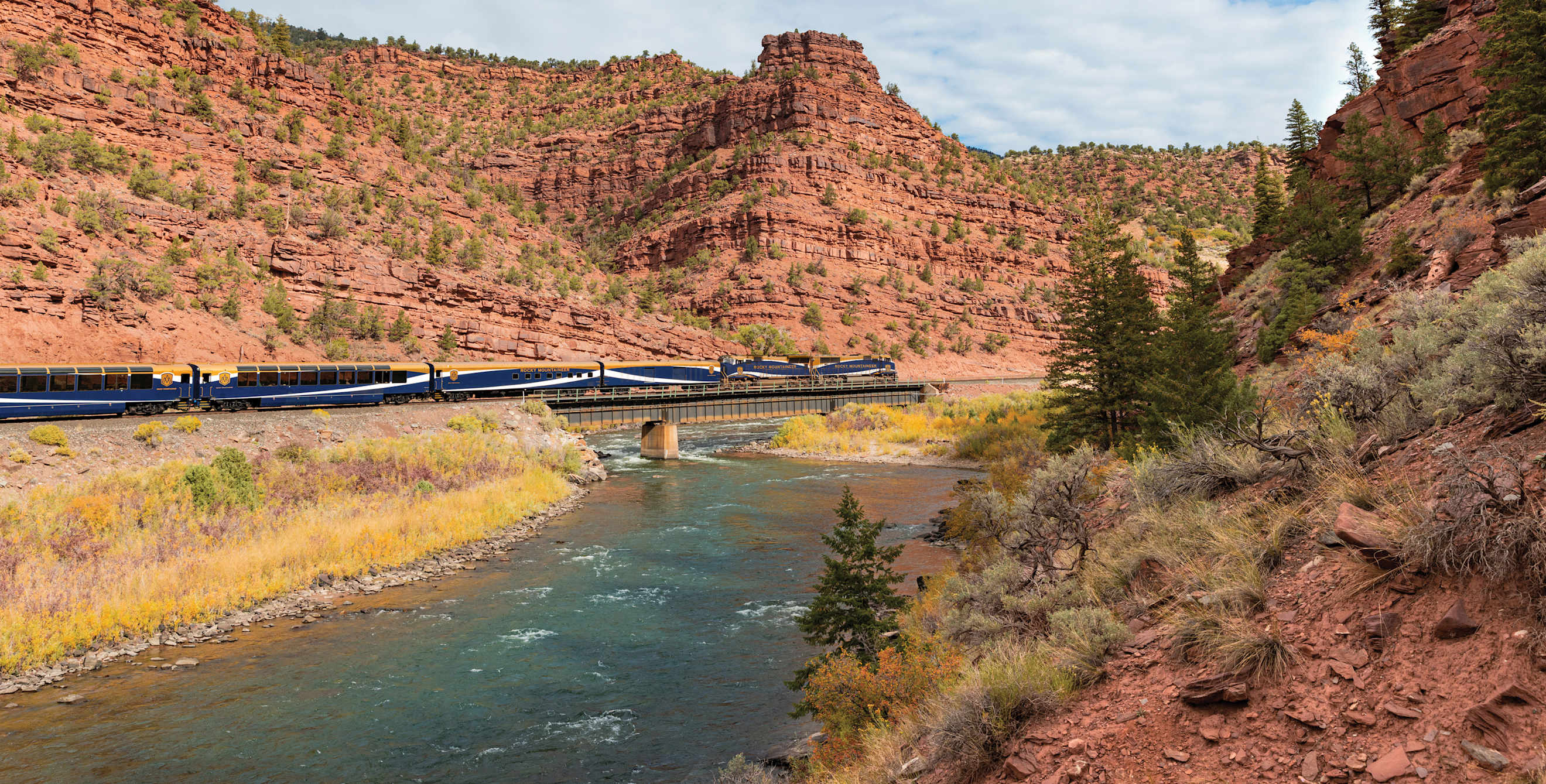
There’s something about the rhythmic turning of a train’s wheels that is simply meditative. The ultimate form of slow travel, railways allow you to sit back and watch the world pass by like a moving picture show, as scenic towns give way to open valleys, rolling foothills, and rising mountain vistas.
Some of the country’s most impressive train journeys happen to be in the West. These are the kinds of places you can’t get to by car: narrow red-rock canyons in the middle of Rocky Mountain wilderness, cliff-hugging tracks that switchback through Sierra conifer forest, and remote Alaskan backcountry brimming with wildlife.
While Amtrak, the U.S. national passenger railway company, operates a few of these, others run the gamut from heritage lines to dedicated rail-tour companies. You’ll find a lot to love about train travel, from superliner cars with sightseeing lounges to sit-down dining cars and en suite sleeper cars.
Ready to leave the car behind and hop the tracks for a one-of-a-kind adventure? Here are six railway journeys that will thrill new riders and train buffs alike.
Best Train for First Timers: Amtrak’s Coast Starlight
One of Amtrak’s most legendary train routes, this 1,377-mile, 35-hour journey between Los Angeles and Seattle runs through many of the West Coast’s greatest cities—including Oakland, San Francisco, Sacramento, and Portland—and traverses some of its most majestic scenery (we’re talking driftwood-scattered beaches, vineyard-covered valleys, and snow-touched mountain peaks).
While the Coast Starlight runs daily in both directions, it’s northbound that travelers can take in some of the most remarkable views, especially during the longer days of summer. Beginning at L.A.’s landmark Union Station, the West Coast’s largest passenger railway terminal, the train heads west toward the Pacific. Once there, it hugs the coastline, providing panoramic ocean vistas dotted with surfers and stand-up paddleboarders, then makes its way to Santa Barbara, where fringy palm trees and red-tiled roofs beckon travelers with a cool seaside vibe.
After offering travelers a distant view of Vandenberg Space Force Base—the West Coast launch center for spacecraft manufacturer SpaceX—the Starlight turns inland, passing through the fertile agricultural lands of Paso Robles and Salinas. Rows of vineyards give way to expansive citrus groves as the sun slowly sets on the horizon, lending an added sense of stillness to the already serene view.
On the following morning the train’s early risers are treated to one of its most inspiring attractions: 14,179-foot Mount Shasta—a potentially active volcano that serves as a striking stand-alone teaser for the many majestic mountain peaks ahead.
The Starlight crosses the Cascade Mountains at Oregon’s Willamette Pass, starting a long, slow descent from upwards of 4,000 feet down to the lush Willamette Valley, tracing the northward-flowing Willamette River, passing alongside Oregon’s longest covered bridge, and showcasing 1,500-foot-wide Willamette Falls. The spectacle of its churning waters is simply breathtaking—a description you’ll hear regularly on this iconic route.
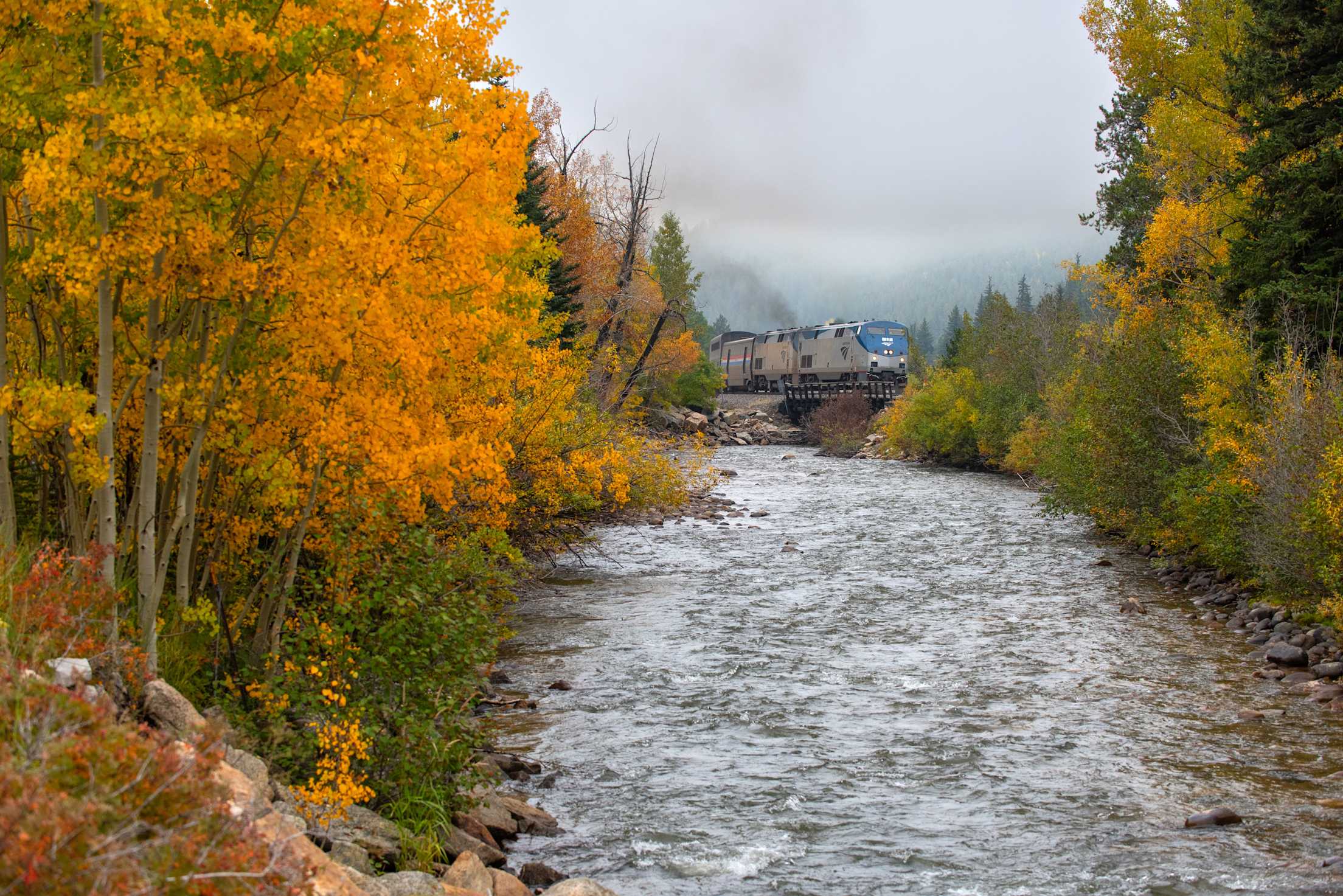
Best Train for Fall Foliage: Amtrak’s California Zephyr
Amtrak’s longest daily train route, a 2,438-mile ride between Chicago and the San Francisco Bay Area’s Emeryville, encapsulates much of America’s natural beauty, with vast cornfields, narrow canyons, and sunlit buttes all part of the scenery. But for autumn leaf-peeping, the western stretch between Reno and Sacramento dazzles. Here, the Zephyr winds its way through the Sierra Nevada Mountains and Tahoe National Forest, passing among dense stands of maple, birch, and oak trees, their leaves in brilliant shades of red, gold, and orange come fall.
The views are especially captivating from the Sierra’s 7,056-foot-high Donner Pass, as the Zephyr traverses a series of remote, cliff-hugging tracks overlooking the woodlands of Donner Memorial State Park and adjacent Donner Lake, its waters a mirror reflecting bright, colorful foliage. Onboard educational guides from Sacramento’s California State Railroad Museum often join this leg of the journey, sharing the area’s history and details on the western Transcontinental Railroad—constructed largely by Chinese immigrants—as you go.
For more autumn vistas, catch the train in Denver and head westward through the Rocky Mountains, where the changing aspen leaves create a vivid yellow landscape in spots. The Zephyr follows the Colorado River for 238 miles here, as the train works its way upwards through steep canyons and past occasional wildlife such as antelope and deer. In the changing light of shorter days, the scenery is especially captivating.
Best Train for a Luxe Getaway: The Rocky Mountaineer’s Rockies to the Red Rocks
Rather than a direct mode of transport, the Rocky Mountaineer’s Rockies to the Red Rocks is a dedicated rail tour. Travelers board the train in either Denver or Moab, Utah, then spend two days traveling between them, taking a break midway to stay at a hotel in Glenwood Springs. This specially designed route showcases some of the West’s most spectacular natural landscapes while treating passengers to perks such as in-seat dining, signature cocktails, and individual railcar hosts who might point out grazing elk, or delve into the history of the track’s Moffat Tunnel, a 6.2-mile passage through the Continental Divide at 9,239 feet in elevation.
You can even extend the trip with curated add-ons, such as motor-coach transport from Salt Lake City or Las Vegas, return train travel, and visits to national parks such as Canyonlands, with its river-formed buttes and enormous flat-topped mesa; and aptly named Arches, abounding with more than 2,000 of these natural rock formations.
Travelers board custom-designed, glass-dome coach cars with oversize windows for taking in sights such as the Colorado Rockies and Utah’s towering hoodoos, slender rock spires formed by millions of years of erosion. Each car features its own designated chef, who serves up orders of wild mountain berry French toast and caprese salads using vine-ripened tomatoes, depending on the time of year.
If you’re willing to pay extra, you can even get access to an exclusive parlor car, complete with a small outdoor viewing area where you can breathe in the fresh mountain air.
The route utilizes some of the same tracks as the California Zephyr, including those between Denver and the Colorado–Utah state line. A run through 25-mile-long Ruby Canyon, named for its stunning red sandstone cliffs, follows the Colorado River. You’ll often spot rafters navigating the stretch’s mellow waters, as well as a few ready and waiting to moon passing trains—a long-standing canyon tradition.
Rocky Mountaineer’s Rockies to Red Rocks route runs between April and October.
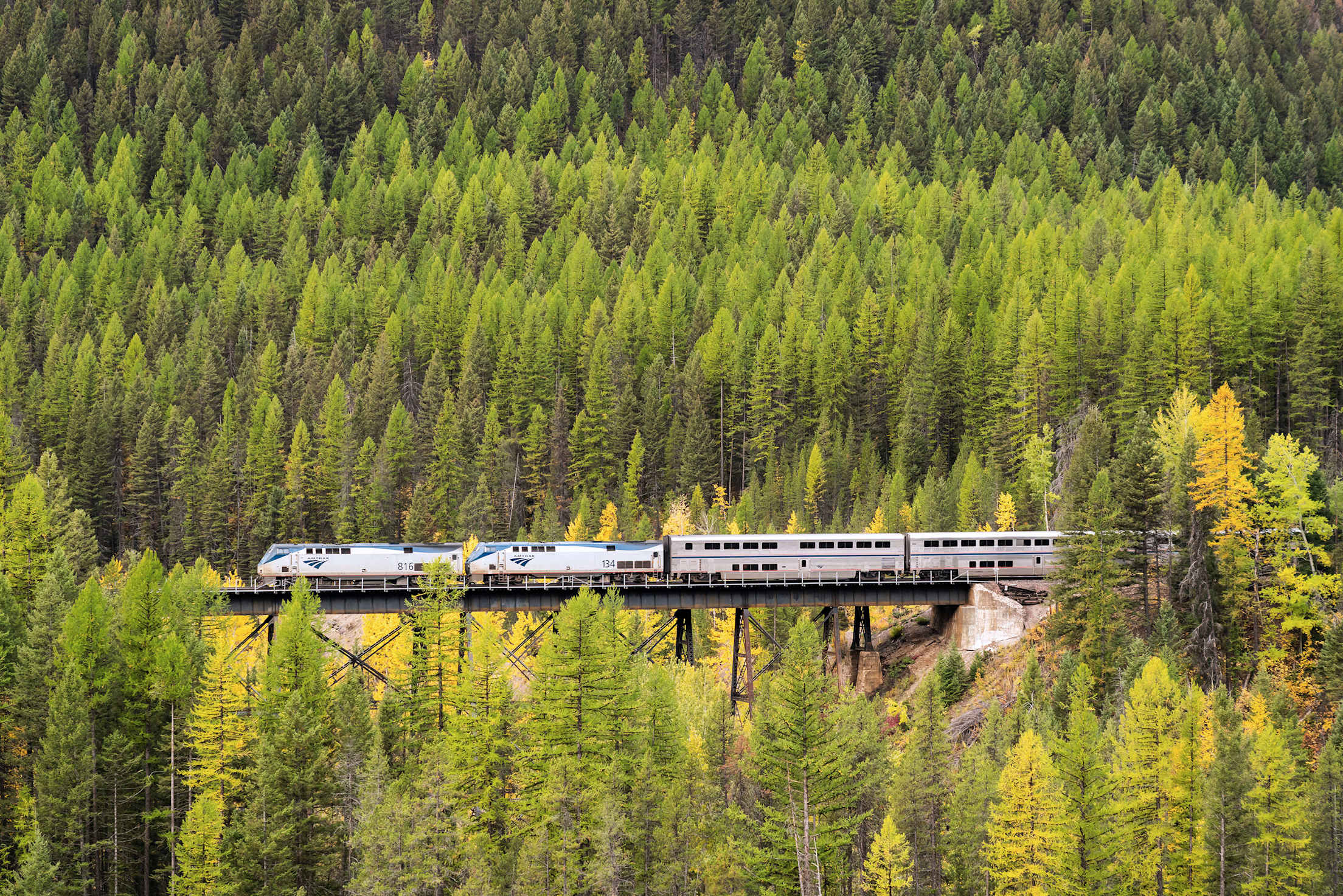
Best Train to See the Power of Nature: Amtrak’s Empire Builder
Traveling largely in the footsteps of pioneer explorers Lewis and Clark, the Empire Builder first began rolling in 1929 as the flagship passenger train of the Great Northern Railway, a transcontinental service that encouraged Americans to “see America first.” Amtrak took over services in 1971, allowing today’s travelers to make the epic journey—more than 2,200 miles—between Chicago in the east to either Seattle or Portland. The western expanse, stretching from the West Coast’s urban centers to Montana’s Big Sky country, offers passengers some of the most jaw-dropping views.
Those traveling from Portland are regaled with the sight of Mount Hood—an 11,249-foot knockout with a crowned peak and perpetual snow—and passage through the Columbia River Gorge, with its sheer basalt walls, dense fir trees, and gushing falls. If you leave from Seattle, you can watch for porpoises breaching in the open waters of Puget Sound; as you continue on through the Cascade Range, you’ll see a geologic mosaic made up of everything from ocean sediments to bits of Earth’s subcrustal mantle.
The two trains link together in Spokane and travel overnight through Idaho, arriving in the Montana mountain resort of Whitefish, with its walkable, historic downtown. From here, the train travels along the Flathead River toward Glacier National Park, the rail lines’s crowning jewel.
Train depots bookend the park on both sides, providing access to West Glacier, a small village in its southwest corner that serves as the park’s western entrance; Lake McDonald (the park’s largest); and Going-to-the-Sun Road, a 50-mile drive that twists its way beneath rock walls, tumbling falls, and eye-popping mountain curves. A remote train station in the park’s southeast corner welcomes passengers to Glacier Park Lodge, constructed from enormous Douglas fir trees and opened in 1913 as the Great Northern Railway’s first railway hotel.
Traveling along the park’s southern edge between the depots, the Empire Builder basks in the staggering beauty of rising mountain peaks; crosses the Continental Divide, which separates North America’s river systems as they flow into various seas; and skirts the property of the Izaak Walton Inn, a historic Tudor revival–style lodge originally built as a dorm for railroad workers.
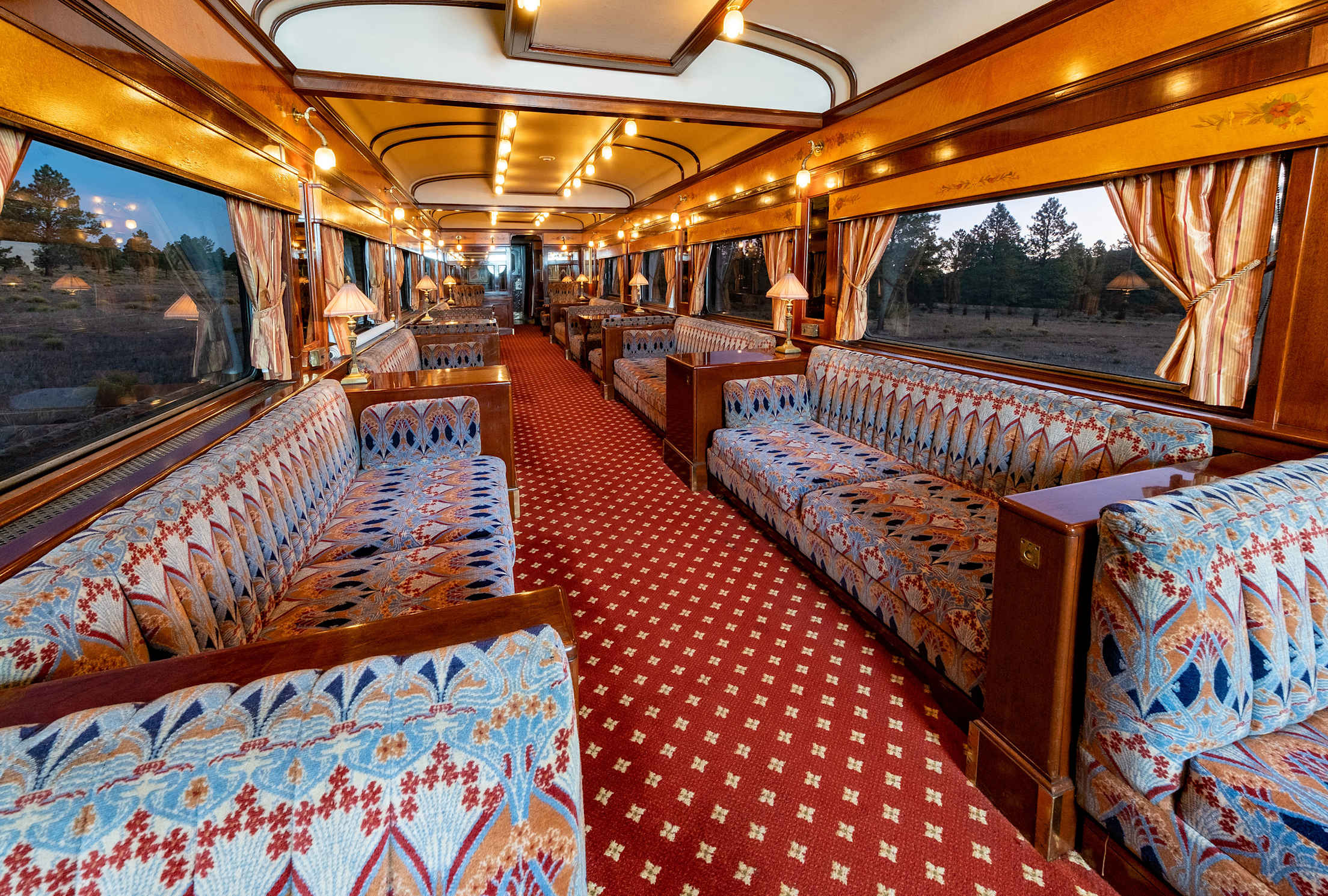
Best Train for Traveling Back in Time: The Grand Canyon Railway
The Grand Canyon Railway’s winding, 64-mile journey between the once-frontier town of Williams, Arizona, and the south rim of Grand Canyon National Park, hearkens back to the days of the Old West. With its bevy of restored vintage railcars, this heritage railway (which made its first trip in 1901) is a rolling venue of living history.
You can choose among six classes of service ranging from Pullman Class—1920s railcars fitted with bench-style seats and windows that open to allow in the breeze—to the Luxury Parlor, an elegant car with cushioned high-back chairs, enclosed dome windows, and its own private bar. On board are strolling guitarists and fiddlers, cowpokes crooning Western classics like “Home on the Range,” and even the occasional “train robbery.” Each car also has a dedicated attendant to share facts about the area and offer tips on the best south rim hikes and lookout points. (Yavapai Point, with its deep canyon views, is especially notable.)
A motley crew of cattle rustlers and train robbers known as the Cataract Creek Gang kicks off the nearly daily railway experience with a “shoot-out” performance at 9 a.m. sharp outside the Williams Grand Canyon Railway Depot. From there, the train meanders past the volcanic San Francisco Peaks, swaths of high desert prairie, and portions of vast ponderosa pine forest.
Once reaching the Grand Canyon, passengers have three hours to explore the park. For example, take a stroll along the 13-mile, mostly paved Rim Trail, or nurse a beer at historic El Tovar Hotel lounge. Or you can book a night at one of the on-site lodgings and return on a separate day.
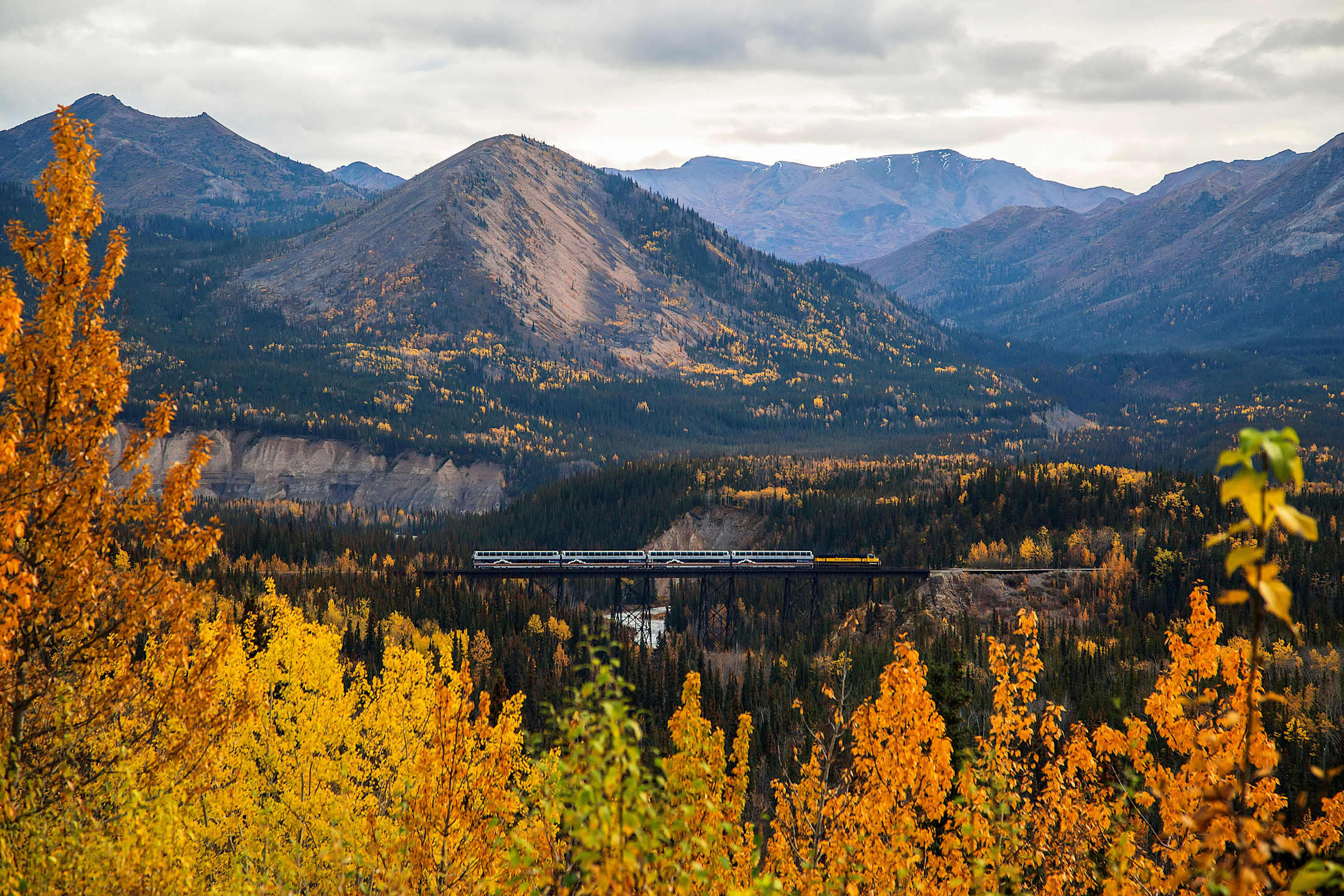
Best Train for Experienced Railway Travelers: Alaska Railroad's Denali Star Train
Even to those for whom riding the rails is a personal pastime, Alaska Railroad’s Denali Star Train stands out as one of the West’s most monumental railway experiences. The entire route spans 350 miles from the state’s largest city, Anchorage, to Fairbanks, but its access to Denali National Park & Preserve—6 million wild acres of taiga forest, high-alpine tundra, and massive mountains—that make this trip truly unforgettable.
The trains run daily, early May through mid-September, departing in the early morning in both directions, and arriving at the final destination around 12 hours later. Traveling north from Anchorage, the train follows the Chugach Mountains (the city’s backyard wilderness) and makes its way toward the quirky town of Talkeetna, with its clapboard storefronts and shops selling everything from sourdough starter to sockeye salmon windsocks. Just before and after town, the views of 20,310-foot Mt. Denali, North America’s tallest peak, are some of the best the railway has to offer, as long as it’s a clear day.
Making its way into Alaska’s backcountry interior, the train continues past the occasional remote log cabin en route to Hurricane Gulch Bridge, a 914-foot-long, steel-arch trestle bridge that stretches 296 feet above the rippling creek below. It’s Alaska’s longest and tallest railway bridge, providing superb views of the valley below and its thick pine forest. By late afternoon, the train pulls into Denali, where you can disembark to explore the park.
Denali Star passengers can choose between a trio of travel options, which include the budget-friendly Adventure Class, the more upscale GoldStar Service with all-inclusive meals (think buffalo chili and reindeer penne Bolognese), and the privately operated Wilderness Express, a dome car with 360-degree window vistas and back-of-the-train views, so you can step outside and see a meandering moose or even the rare grizzly bear.
Book your dream train trip with AAA Travel and enjoy exclusive Member benefits.